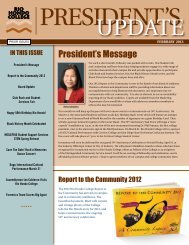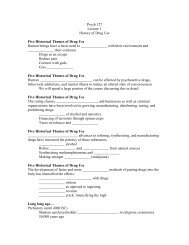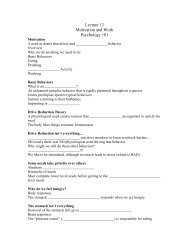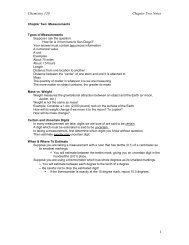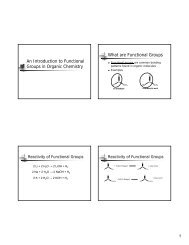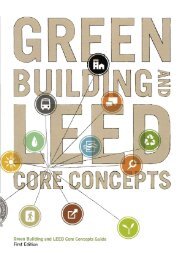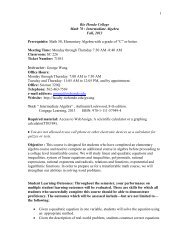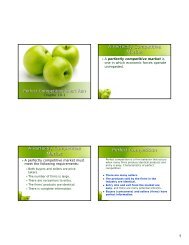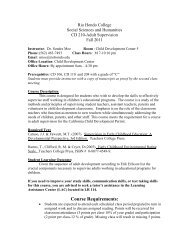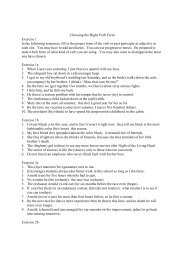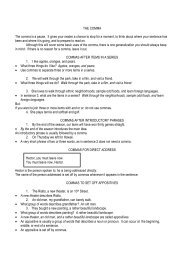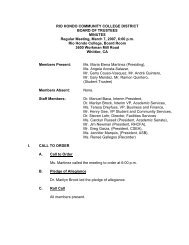Complete College Catalog 2011-2012 - Rio Hondo College
Complete College Catalog 2011-2012 - Rio Hondo College
Complete College Catalog 2011-2012 - Rio Hondo College
Create successful ePaper yourself
Turn your PDF publications into a flip-book with our unique Google optimized e-Paper software.
and crew all positions, including<br />
writer, producer, director, 1st assistant<br />
director, 2nd assistant director,<br />
lighting director, gaffer, camera<br />
operator, boom operator, and editor.<br />
Emphasis will be placed on defining<br />
the content, structure, and style of the<br />
production. This course may be of<br />
interest to students interested in both<br />
film and television production.<br />
3 Units<br />
36 Lecture hours<br />
54 Lab hours<br />
TV 137<br />
Introduction to Studio/Field Multi-<br />
Camera Production (EFP)<br />
Advisory: ENGL 035 or ESL 198 or<br />
appropriate assessment; READ 022 or<br />
appropriate assessment<br />
Transfers to: CSU<br />
This is a basic course in multi-camera<br />
television production. Topics will<br />
include the theory of NTSC and ATV<br />
(HDTV) television system operation;<br />
camera set-up and handling; live<br />
video mixing, layering and recording;<br />
video text and graphics; and audio<br />
and lighting fundamentals. Students<br />
crew all positions, including writer,<br />
producer, director, 1st assistant<br />
director, 2nd director, lighting director,<br />
floor manager, camera operator,<br />
technical director (video switcher),<br />
audio engineer, recording engineer,<br />
and graphics operator. Emphasis is on<br />
defining structure, style, and content<br />
of film and television production. This<br />
course may be of interest to students<br />
interested in film and television<br />
production.<br />
3 Units<br />
36 Lecture hours<br />
90 Lab hours<br />
TV 138<br />
Video Editing Lecture<br />
Prerequisite/Corequisite: TV 137<br />
Advisory: ENGL 030 or ESL 197 or<br />
appropriate assessment; READ 022 or<br />
appropriate assessment<br />
Transfers to: CSU<br />
This is a course in the history and<br />
techniques of motion picture and<br />
television image editing. Students<br />
will view, discuss, and evaluate the<br />
evolution of the art, ranging from the<br />
earliest motion pictures to current<br />
video commercials. Emphasis is on<br />
defining structure, style, and content<br />
of film and television editing. This<br />
course is intended for all students<br />
with an interest in film and television<br />
editing, and who have completed<br />
or are concurrently enrolled in an<br />
introductory television production<br />
course.<br />
3 Units<br />
54 Lecture hours<br />
TV 195<br />
ENG/Single Camera Production<br />
Lecture<br />
Advisory: TV 137 with a grade of “C”<br />
or better<br />
Transfers: CSU<br />
This is a basic course in television<br />
production techniques. This course<br />
will instruct the student in lighting,<br />
camera, audio and field acquisition<br />
techniques involved in dramatic,<br />
news and documentary, single camera<br />
production.<br />
2 Units<br />
36 Lecture hours<br />
TV 196<br />
ENG/Single Camera Production Lab<br />
Advisory: TV 137 with a grade of “C”<br />
or better<br />
Transfers: CSU<br />
This is a basic course in television<br />
production techniques. This course<br />
will provide hands on training in<br />
scripting, lighting, camera, audio and<br />
field acquisition techniques involved<br />
in dramatic, news and documentary,<br />
single camera production. This course<br />
may be taken once and repeated three<br />
times for credit.<br />
1 Unit<br />
54 Lab hours<br />
TV 199<br />
Television Internship<br />
Prerequisite: TV 237 and TV 238 with a<br />
grade of “C” or better<br />
Transfers to: CSU<br />
This course is designed to provide<br />
television students with on-the-job<br />
training in the profession. Students<br />
will meet with the instructor one hour<br />
each week to receive instruction in the<br />
specific area of internship. Students<br />
may be involved in any or all of the<br />
following professional areas: cable,<br />
industrial, education or broadcast<br />
television production - videography,<br />
audio, graphics, technical direction,<br />
editing, lighting, or directing. This<br />
course may be taken once and<br />
repeated one time for credit.<br />
3 Units<br />
18 Lecture hours<br />
144 Lab hours<br />
TV 237<br />
Advanced Studio/Field Multi-Camera<br />
Production<br />
Prerequisite: TV 137 with a grade of<br />
“C” or better<br />
Transfers to: CSU<br />
This is a continuation of the basic course<br />
in multi-camera television production<br />
(TV 137), which expands the student’s<br />
knowledge of production skills,<br />
including the following: NTSC and ATV<br />
(HDTV) television system signal systems<br />
and their operational characteristics;<br />
camera handling skills; live video<br />
mixing; advanced layering within the<br />
switcher; advanced video text (CG)<br />
operation; 2D animated graphics; and<br />
advanced audio and lighting techniques.<br />
Students crew all positions including<br />
writer, producer, director, 1st assistant,<br />
2nd assistant director, lighting director,<br />
floor manager, camera operator,<br />
technical director (video switcher), audio<br />
engineer, video engineer, recording<br />
engineer, and graphics operator. This<br />
course is intended for all students<br />
with an interest in film and television<br />
editing, and who have completed an<br />
introductory television production<br />
course.<br />
3 Units<br />
36 Lecture hours<br />
90 Lab hours<br />
TV 238<br />
Video Editing Lab<br />
Corequisite: TV 138<br />
Advisory: ENGL 030 or ESL 197 or<br />
appropriate assessment; READ 022 or<br />
appropriate assessment Transfers: CSU<br />
This is a course in the techniques of<br />
television image editing. Students<br />
engage in supervised laboratory<br />
experience in the fundamental<br />
characteristics of linear and nonlinear<br />
editing systems, leading to<br />
competence in linear, AVID, and final<br />
cut PRO editing systems. Emphasis<br />
is on integrating structure, style, and<br />
content. This course is in intended<br />
for students who with to learn linear<br />
and non-linear editing hardware and<br />
software. This course may be repeated<br />
three times for credit.<br />
2 Units<br />
18 Lecture hours<br />
54 Lab hours<br />
TV 239<br />
Television Engineering<br />
Prerequisite: Completion of TV 237<br />
with a grade of “C” or better<br />
Transfers: CSU<br />
This course is an introduction to<br />
broadcast television engineering<br />
requirements. The course will identify<br />
video signal characteristics, the<br />
function and uses of signal monitoring<br />
scopes, proper maintenance of camera<br />
optics, camera setup and alignment,<br />
videotape recorder maintenance<br />
and video system diagnostics, audio<br />
recorder maintenance and audio signal<br />
monitoring.<br />
3 Units<br />
36 Lecture hours<br />
90 Lab hours<br />
TV 290<br />
Cooperative Work Experience/<br />
Internship for Television Production<br />
Related Fields<br />
Advisory: ENGL 035 or ESL 198 or<br />
appropriate assessment; READ 023 or<br />
appropriate assessment<br />
Transfers to: CSU<br />
This course supports and reinforces<br />
on-the-job training in business,<br />
industrial, studio, broadcast,<br />
community and professional television<br />
organizations under supervision of<br />
a college instructor and is facilitated<br />
by the use of learning objectives. The<br />
student will be working in a skilled<br />
or professional level assignment in<br />
their area of vocational interest and<br />
will meet performance objectives<br />
related to instruction that are above<br />
and beyond the conditions of regular<br />
employment. This course is intended<br />
for students whose job is related to<br />
the field of television production and<br />
have completed or enrolled in the<br />
appropriate coursework. Instructor<br />
approval is required to remain in the<br />
class. This course may be taken once<br />
and repeated for a maximum of 16<br />
units.<br />
Student Unpaid Internship:<br />
1 Unit/60 hours; 2 Units/120 hours;<br />
<strong>2011</strong>-<strong>2012</strong> <strong>Catalog</strong> <strong>Rio</strong> <strong>Hondo</strong> <strong>College</strong> / 249



